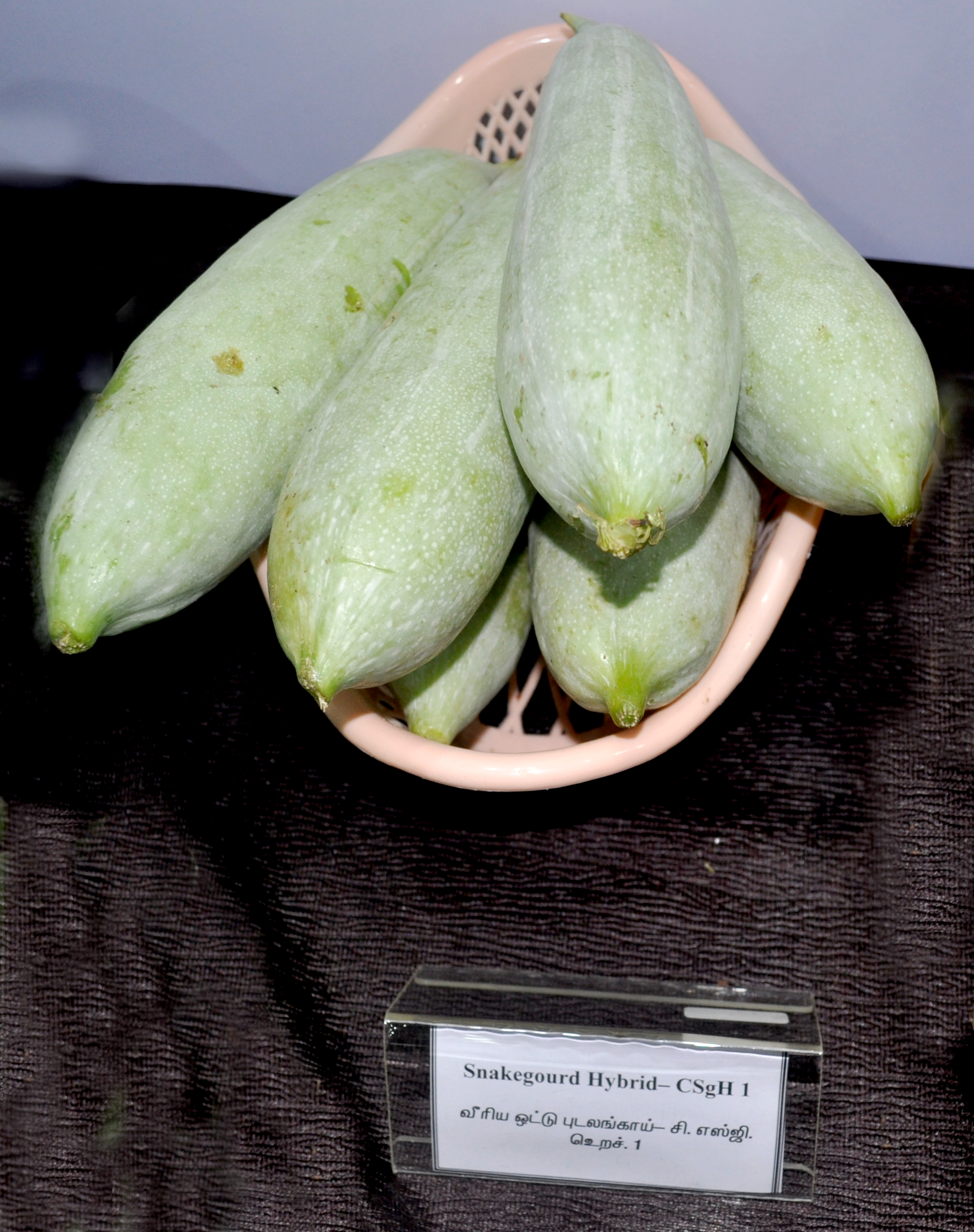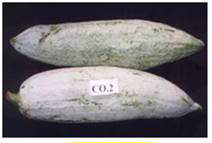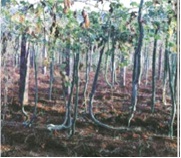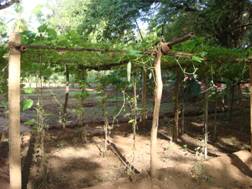Snake gourd (Trichosanthes cucumerina. L)
Cucurbitaceae
Varieties
CO1, CO 2, PKM 1, PLR 1, PLR 2 and Baby..
Hybrid
Snake gourd COH1..
 |
 |
| Snakegourd Hybrid - CSgH 1 |
Snakegourd - PKM 1 |
CO.1 :
It is a pure line selection from a local type of Alangulam. The fruits are 160-180cm long, Dark green skin with white stripes with in yield potential of 18 t/ha in a crop duration of 135 days.
|
|
MDU 1:
It is F1 hybrid of Thaniyanmangalam selction and local short fruit type. Fruits 60cm long with white stripes under green backround
|

|
CO.2 :
It is pure line selection from local type of Coimbatore district. Fruits are short (30-35cm)
Stout, light greenish white without stripes and have a ashy bloom on the surface. Yield potential is 25-30 t/ha in 125-130 days
|
 |
PKM 1:
It is a induced mutant from H375 with in yield potential of 25t/ha in 135-140 days. The fruits are extra long (180-200cm) |
Soil
Sandy loam soils rich in organic matter with good drainage and the pH ranging from 6-5-7.5
Season
July and January are highly suitable for cultivation.
Seed treatment
Treat seeds with Trichoderma viride 4 g/kg or Pseudomonas fluorescens 10 g/kg or Carbendazim 2 g/kg of seeds before sowing.
Seed rate
1.5 kg of seeds/ha is required. |
1.png) |
| PLR(SG)1 |
|
Preparation of field
Plough the field to fine tilth and dig pits of size 30 cm x 30 cm x 30 cm at 2.5 x 2 m spacing and form basins.
Sowing
Sow the seeds (5 seeds / pit) and thin the seedlings to two/pit after 15 days of sowing.
Irrigation
Irrigate the basin before dibbling the seeds and thereafter once a week.
Application of fertilizers
Apply 10 kg of FYM, 100 g of NPK 6:12:12 mixture as basal dose per pit and N @ 10 g pit 30 days after sowing. Apply Azospirillum and Phosphobacteria @ 2 kg/ha and Pseudomonas 2.5 kg/ha along with FYM 50 kg and neem cake @ 100 kg before last ploughing.
After cultivation
Hoeing and weeding can be done thrice or as and when necessary. Provide stakes and train the plants to reach the pandal height (2 m). Pandal is not essential for Co 2 variety. Spray Ethrel 100 ppm (1 ml in 10 lit of water) four times from 10 to 15 days after sowing at weekly intervals.

Snake gourd grown in pandal system
Quality seedling production
Nursery raising
Sow the snake gourd seeds in protrays containing well decomposed cocopeat medium. Sow only one seed per cell. Keep the trays under shadenet house. Water regularly with the help of rose can. Transplant about 12 days old seedlings to main field.
Planting
Spread the lateral tubes on the raised beds of 120cm wide at 150cm spacing. Irrigate the beds by operating the drip system continuously for 8-12 hrs. Plant the seedlings in the holes made at 60cm spacing.
Fertigation
Apply a dose of 75:100:100 kg NPK/ha throughout the cropping period through split application. Apply 75% of the phosphorus as superphosphate as basal dose.
Plant protection
Pests
Leaf beetles and leaf caterpillars
Spray Dichlorvos 76% EC 6.5 ml/10 lit or Trichlorofon 50% EC 1.0 ml/l.
Fruit fly
1. Collect the damaged fruits and destroy.
2. The fly population is low in hot day conditions and it is peak in rainy season. 3. Hence, the sowing time may be adjusted accordingly.
4. Expose the pupae by ploughing.
5. Use 20 x 15 cm poly bags fish meal traps with 5 g of fish meal + 1 ml of Dichlorvos in cotton @ 50 traps/ha. Fish meal and cotton are to be removed once in 20 and 7 days respectively.
6.Neem oil @ 3.0 % need based as foliar spray
7.
For management of Aphid vector, spray Imidachloprid @ 0.5 ml/lit along with sufficient quantity of stickers like Teepol, Triton X100, APSA etc., for better adhesion and coverage.
Do not use DDT, copper and sulphur dust. These are phytotoxic.
Diseases
Powdery mildew
Powdery mildew can be controlled by spraying Dinocap 1 ml/lit or Carbendazim 0.5 g/lit.
Downy mildew
Downy mildew can be controlled by spraying Mancozeb or Chlorothalonil 2 g/lit twice at 10 days interval.
CIB recommendation
Spray ametoctradin + dimethomorph 20.27% w/w SC @ 0.04%.
Yield
18 t/ha in 135 – 145 days.
Hybrid
65-70 t/ha in 135 – 175 days.
Market information
Crop Growing districts |
Cuddalore, Coimbatore, Dindigul |
Major markets in Tamil Nadu |
Periyar Vegetable Market Koyambedu, Chennai
Gandhi Market, Oddanchathiram
Natchipalayam Vegetable Market, Coimbatore |
|





1.png)
